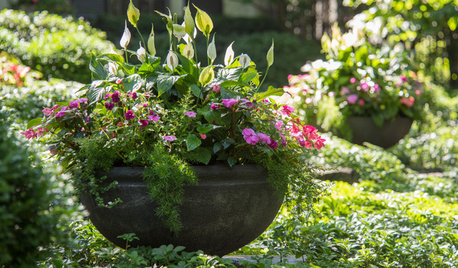Sulking hellebore
divamum
16 years ago
Related Stories

GARDENING GUIDES14 Beautiful Container Gardens for Shady Spots
These dynamic potted plant combinations thrive in partial to full shade — perfect for the porch or a shady bed
Full StorySponsored
I planted it last summer. It's in shade. It had compost on planting, and was mulched all summer. I watered it when it looked like it needed it. And it has just.... sulked. It hasn't changed size much since planted, and it hasn't bloomed. It's sorta droopy.
We have soil which tends towards acidic and has more rocks than one really wants, but I picked out the big stones when I planted and also added some compost and plenty of mulch; it also gets naturally mulched by leaves falling from the trees around it. I can't remember specifically, but I'm pretty sure there were no significant roots immediately around where i planted it - obviously, with trees all around there ARE roots, but I think it's immediate vicinity was sort of between larger root sprawl.
What does its little photosynthesizing self want/need to thrive and bloom?

razorback33
divamumOriginal Author
Related Professionals
Ballenger Creek Landscape Architects & Landscape Designers · Kyle Landscape Architects & Landscape Designers · Severn Landscape Architects & Landscape Designers · Aurora Landscape Contractors · Waterbury Landscape Contractors · Wakefield Landscape Contractors · Cliffside Park Landscape Contractors · Goodlettsville Landscape Contractors · Hilo Landscape Contractors · Oak Forest Landscape Contractors · Oxnard Landscape Contractors · The Woodlands Landscape Contractors · West Haverstraw Landscape Contractors · Euless Siding & Exteriors · Linden Siding & Exteriorsmikeybob
gardengal48 (PNW Z8/9)
razorback33
gardengal48 (PNW Z8/9)